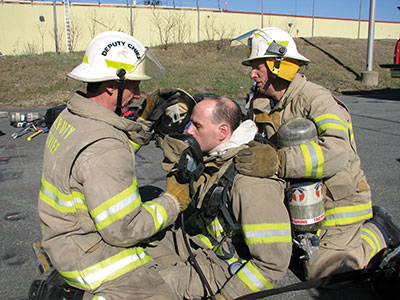
Back to Basics: October 2013
Mark Van
Features Fire Ground TrainingOne of the most integral parts of the self-contained breathing apparatus (SCBA) is the facepiece.
One of the most integral parts of the self-contained breathing apparatus (SCBA) is the facepiece. It protects the firefighter from inhaling the superheated air that is in the environment, and it protects the firefighter from debris coming into contact with his face. The SCBA facepiece is designed and tested to withstand harsh environments in hot and cold temperatures. With the new NFPA standards, the facepiece is required to withstand a set temperature over a period of time.
When the facepiece fails, it produces catastrophic results for the firefighter. This involves not only burns to the face, but to the lungs, trachea and esophagus, as well. There was a case of a facepiece failure at a training tower in Pennsylvania in 2006; an instructor lighting the last fire in the burn tower for the day suffered major burns to the outside and inside of his facial and respiratory area. The lens of the facepiece had suddenly melted, exposing him to the superheated air in the burn room. This is one example of how a facepiece can fail. Other failures can involve debris falling onto the firefighter, either knocking away the facepiece or breaking its lens.
When this type of incident occurs, the RIT will be initiated to rescue the downed firefighter. RIT members will likely conduct a full nine-step assessment of the firefighter to determine his air-supply needs.
We are going to look at how to conduct a facepiece changeover.
First, let’s review the nine steps involved in assessing the downed firefighter:
- Locate and turn off the PASS device
- Call command
- Check breathing
- Check bottle supply status/pressure gauge reading
- Change/introduce new air supply
- Recheck breathing
- Check for entrapment
- Secure RIT pack
- Remove firefighter
If the downed firefighter is not breathing on his own, stop the nine-step assessment and concentrate on removing the firefighter right away. It is more important to remove the firefighter so that immediate medical care can be administered than to try to complete the nine-step process. In essence, the rescue team is checking the ABCs of first aid.
The facepiece changeover process begins with the RIT pack outside at the RIT staging area. This is where the facepiece is readied prior to making entry into the building for the RIT operation. This involves ensuring that the regulator is attached to the face piece, that the air cylinder is opened all the way and is full and that the head harness straps are fully retracted and perhaps folded over the front of the facepiece for easier application (see photo 1).
 |
|
| Photo 1: Ready the facepiece before making entry. This involves ensuring that the regulator is attached to the facepiece, that the air cylinder is opened all the way and is full, and that the head harness straps are fully retracted and perhaps folded over the front of the facepiece for easier application. | |
 |
|
| Photo 2: The rubber head harness, pictured above, does not stretch as easily as a Nomex head harness, and can get caught on the firefighter’s hair, making the transition to the new facepiece much more difficult. | |
 |
|
| Photo 3: Once the downed firefighter is in the seated position, one of the RIT firefighters kneels behind the downed firefighter and the other RIT firefighter is positioned in front of the downed firefighter. | |
 |
|
| Photo 4: The RIT firefighter positioned behind the downed firefighter removes the downed firefighter’s original facepiece. The other RIT firefighter in the front of the downed firefighter replaces the original facepiece with a new one. Photos by Mark van der Feyst |
In the case of mutual-aid RIT, make sure that the SCBA being worn by the mayday firefighter will work with the RIT kit of the mutual-aid RIT. All SCBA brands, such as Scott and MSA, are incompatible with one another. If this is the case, the RIT kit will need to have the proper regulator.
It is also a good idea to make sure that the RIT facepiece has a Nomex head harness as opposed to a rubber head harness. The rubber head harness does not stretch as easily as Nomex and can get caught on the firefighter’s hair, making the transition much more difficult (see photo 2). The Nomex head harness stretches much more easily and is also hair-friendly. The neck strap of the facepiece also needs to be removed because it will become an entanglement hazard when trying to fit the RIT facepiece onto the downed
firefighter’s face.
To get the downed firefighter ready for the facepiece changeover, the two RIT members will put the downed firefighter in a seated position. This involves grabbing the SCBA shoulder strap of the downed firefighter and pulling the strap up so that the downed firefighter’s upper body sits up. Once in this position, one of the RIT firefighters kneels behind the downed firefighter and the other RIT firefighter is positioned in front of the downed firefighter (see photo 3).
In a situation in which the downed firefighter cannot be seated up – if he is pinned by rubble, for example – then the RIT firefighters must adapt to the downed firefighter’s position. This may involve lying in front of and behind the downed firefighter so that the same access can be gained.
As in photo 4, the RIT firefighter positioned behind the downed firefighter removes the downed firefighter’s facepiece. The other RIT firefighter in the front of the downed firefighter replaces the original facepiece with a new one. Preparation involves the front RIT firefighter getting the RIT pack ready with the new facepiece connected and ready to go, while the rear RIT firefighter removes the mayday firefighter’s helmet, and pulls back his flash hood. The rear RIT firefighter then places his gloved hand on the lens of the downed firefighter’s facepiece to hold it to his face. With his free hand, the RIT firefighter will pull the netting of the facepiece over the front of the downed firefighter’s face.
Once both RIT firefighters are ready, the front RIT firefighter positions the new facepiece in front of the old one so that when the rear RIT firefighter removes the original one, the new facepiece can be quickly applied to the downed firefighter’s face with minimal exposure. The downed firefighter will be temporarily exposed to the conditions around him, so the timing of the operation must be precise to limit the exposure. The purge valve should be opened to push away the contaminants in the air from the face and to provide a supply of air at the same time. The purge valve needs to be opened all the way on both facepieces prior to the removal of the original one. Once the new facepiece is on, the flash hood and helmet are put back on and the downed firefighter can be readied for removal.
Mark van der Feyst is a 14-year veteran of the fire service. He works for the City of Woodstock Fire Department in Ontario. Mark instructs in Canada, the United States and India and is a local-level suppression instructor for the Pennsylvania State Fire Academy and an instructor for the Justice Institute of B.C. E-mail Mark at Mark@FireStarTraining.com
Print this page